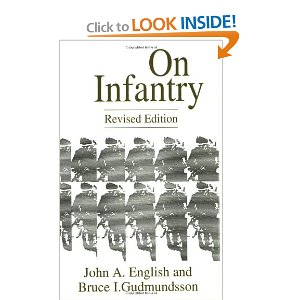
John English and Bruce Gudmundsson
![]() Infantry won WWII, English explains why, August 13, 2000
Infantry won WWII, English explains why, August 13, 2000
John English is a brilliant tactician and historian who has written THE masterpiece on the origins of Infantry. I would have English describe infantry to about the Vietnam era and have Col Dan Bolger take the coverage from there to the future in his own book Death Ground: American infantry in battle. Bruce Gudmundsson was attached to the updated English book to attempt to bring the work up to date.
Taking the masterpiece for what it is, it delivers an important lesson mechanized maneuverists do not want to realize—that the German “blitzkrieg” died in the forests and cities of Russian when it met infantry that would not crumble if surrounded or cut-off from comfortable supply lines. Using a defense-in-depth, a nation on a total war footing can absorb and defeat another less committed nation that hopes to use a smaller force to penetrate and collapse. Many, maybe even most people mistake the German defeat in Russia–and hence WWII—with the cold Russian winter, and this is incorrect. The next critical—perhaps most important lesson and contribution English makes to the defense of freedom is—that a mechanized “combined arms” unit is ONLY AS GOOD AS ITS INFANTRY. When terrain and weather go sour, artillery and tanks will reach a point where they cannot contribute–and the entire battle then falls on the infantry. When this took place in Russia–the German infantry was NOT up to the task with inadequate numbers, clothing and bolt-action rifles. English points out and lesser historians should take note–that the German war machine was good together but not really that good because its PARTS were weak. When combined-arms technotactics could not be employed in the forests of Russia, the battle rested on the German infantry and it failed.
The cryptic lesson here is that we need GOOD infantry in large numbers and we don't get it by placing them into the back of armored vehicles in less than squad sizes, shut off from what's going on because they can't open a hatch out and see because we put a turret on the vehicle and we are afraid it will rotate into them. The Army made this mistake with the Bradley Fighting Vehicle, is trying to correct it with its vehicle for the new Brigade Combat Teams while the marines are about to repeat the error with a huge autocannon turret on their next generation amphibious assault vehicle. The second lesson of English is still being ignored—those that do mechanized combined arms don't value infantry action—they ride too long in their vehicles and get ambushed by missiles and RPGs fired from enemies hiding in key terrain that should have been taken first by the infantry. To do this you need a large amount of aggressive, not complacent infantry. As the Russians found out in Grozny, when their armored vehicles became flaming coffins, the battle then falls on the infantry to clear out enemies hiding in urban terrain.
This is not to say English believes in a “Super Infantry” since we saw in Mogadishu the best light infantry in the world get shot up because it was without armored fighting vehicles to shield it from enemy fire. What English is saying is that we should start with quality infantry when building forces and not in the process of creating combined-arms organizations ruin the infantry capability by reducing numbers, battle awareness and use as a separate maneuver element.
On Infantry should be required reading for ALL U.S. military personnel coupled with Bolger's Death Ground. I'd like to see the book updated to the present with a fresh perspective for the 21st Century where we apply English's lessons to the future battlefield.




